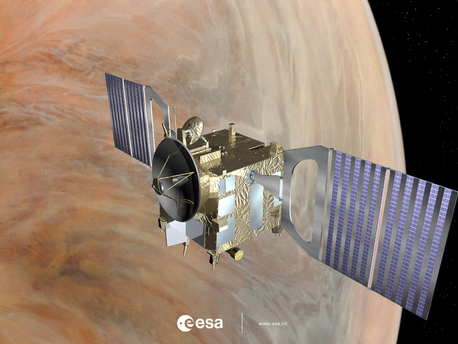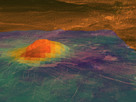Venus Express
Venus Express
 © ESA/AOES Medialab
|
Venus Express has two solar cell panels per wing comprising alternating rows of standard triple junction solar cells as well as highly reflective mirrors to reduce the operating temperatures. There is twice as much sunlight in Venusian orbit as there is in Earthis orbit, plus additional thermal input from the Venusian surface and atmosphere – 75% of sunlight being reflected up from it. In certain cases, this results in Venus Express receiving an equivalent of the thermal input from 3.5 Suns.
Eric Chassefière, Université Paris-Sud, France, has developed a computer model that suggests the water was largely atmospheric and existed only during the very earliest times, when the surface of the planet was completely molten. As the water molecules were broken into atoms by sunlight and escaped into space, the subsequent drop in temperature probably triggered the solidification of the surface. In other words: no oceans.
Although it is difficult to test this hypothesis it is a key question. If Venus ever did possess surface water, the planet may possibly have had an early habitable phase.
Even if true, Chassefière’s model does not preclude the chance that colliding comets brought additional water to Venus after the surface crystallised, and these created bodies of standing water in which life may have been able to form.
There are many open questions. “Much more extensive modelling of the magma ocean–atmosphere system and of its evolution is required to better understand the evolution of the young Venus,” says Chassefière.
When creating those computer models, the data provided by Venus Express will prove crucial.
Source: ESA - European Space Agency
Venus Express
Venus Express
 © ESA/AOES Medialab
|
Venus Express has two solar cell panels per wing comprising alternating rows of standard triple junction solar cells as well as highly reflective mirrors to reduce the operating temperatures. There is twice as much sunlight in Venusian orbit as there is in Earthis orbit, plus additional thermal input from the Venusian surface and atmosphere – 75% of sunlight being reflected up from it. In certain cases, this results in Venus Express receiving an equivalent of the thermal input from 3.5 Suns.
Eric Chassefière, Université Paris-Sud, France, has developed a computer model that suggests the water was largely atmospheric and existed only during the very earliest times, when the surface of the planet was completely molten. As the water molecules were broken into atoms by sunlight and escaped into space, the subsequent drop in temperature probably triggered the solidification of the surface. In other words: no oceans.
Although it is difficult to test this hypothesis it is a key question. If Venus ever did possess surface water, the planet may possibly have had an early habitable phase.
Even if true, Chassefière’s model does not preclude the chance that colliding comets brought additional water to Venus after the surface crystallised, and these created bodies of standing water in which life may have been able to form.
There are many open questions. “Much more extensive modelling of the magma ocean–atmosphere system and of its evolution is required to better understand the evolution of the young Venus,” says Chassefière.
When creating those computer models, the data provided by Venus Express will prove crucial.
Source: ESA - European Space Agency






